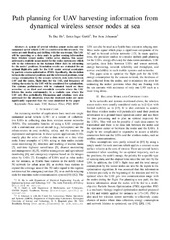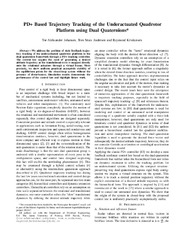Blar i tittel Artikler, rapporter og annet (elektroteknologi)
Viser treff 74-93 av 118
-
Observations of sunlit N2+ aurora at high altitudes during the RENU2 flight
(Journal article; Tidsskriftartikkel; Peer reviewed, 2021-09-24)We present measurements of sunlit aurora during the launch of the Rocket Experiment for Neutral Upwelling 2 (RENU2) on the 13 December 2015, 07:34 UTC. The in situ auroral conditions coincide with those of sunlit aurora and were characterised by the 391.4 and 427.8 nm N<sub>2</sub> <sup>+</sup> emissions. A correlation between several auroral wavelengths, as measured by a meridian-scanning ... -
Optical water types of the Nordic Seas and adjacent areas
(Journal article; Tidsskriftartikkel; Peer reviewed, 2013-05-20)A new map of Jerlov's optical water types in the Nordic Seas and adjacent waters at 139 locations, as well as a table with statistical and geographical properties of the vertical attenuation coefficient of downward irradiance at 475 nm, are presented. The data analysis is based on 715 recordings at different stations, at latitudes between 54° and 82°N, and longitudes between 31°W and 49°E, obtained ... -
Optimal power flow based coordinated reactive and active power control to mitigate voltage violations in smart inverter enriched distribution network
(Journal article; Tidsskriftartikkel; Peer reviewed, 2023-03-30)Voltage violations are the main problem faced in distribution networks (DN) with a higher penetration of inverter-based generations (IBG). Active and reactive power control from smart inverters (SI) can mitigate such violations. Optimal power flow (OPF)-based control provides more accurate operating set points for the coordinated operation of SIs. Therefore, this paper presents a three-phase OPF-based ... -
Optimal Solutions for Underwater Capacitive Power Transfer
(Journal article; Tidsskriftartikkel; Peer reviewed, 2021-12-09)Capacitive power transfer (CPT) has attracted attention for on-road electric vehicles, autonomous underwater vehicles, and electric ships charging applications. High power transfer capability and high efficiency are the main requirements of a CPT system. This paper proposes three possible solutions to achieve maximum efficiency, maximum power, or conjugate-matching. Each solution expresses the ... -
Path planning and reactive based control for a quadrotor with a suspended load
(Conference object; Konferansebidrag, 2021-06)This paper presents a solution to quadrotor cargo transportation, more precisely when cargo is suspended as a sling load. The challenge lies in payload position control and swing attenuation, which we approach by dividing the model into subsystems: attitude quadrotor in free flight, and translational and attitude load dynamics. We propose a solution based on reactive control, in the sense that we ... -
Path planning for UAV harvesting information from dynamical wireless sensor nodes at sea
(Journal article; Tidsskriftartikkel; Peer reviewed, 2022-08-16)A system of several wireless sensor nodes and one unmanned aerial vehicle (UAV) is considered in this research. The nodes are only floating and drifting with the sea stream. The UAV will be operating as a data mule to gather sensing information from wireless sensor nodes. Unlike prior studies, this paper addressed a realistic ocean model for the nodes movements which will be the references to the ... -
Path-following in three dimensions using quaternions for a fixed-wing UAV
(Conference object; Konferansebidrag, 2017-08-08)This paper presents a three dimensional guidance strategy for fixed-wing UAVs using quaternions. The algorithm is based on constructing two quaternions, one which makes the UAV fly towards the path and one that makes the UAV follow the path. These two quaternions are then blended together such that the path-following objective is reached. The guidance algorithm is applied to a simple kinematic model ... -
PD+ based trajectory tracking of the underactuated quadrotor platform using dual quaternions
(Journal article; Tidsskriftartikkel; Peer reviewed, 2019-08-29)We address the problem of state feedback trajectory tracking of the underactuated quadrotor platform in the dual quaternion framework through a PD+ tracking controller. The control law negates the need of generating a desired attitude trajectory as the translational error is mapped directly onto the rotational actuators through a virtual frame. More precisely, we show uniform practical asymptotic ... -
Performance Analysis of Bidirectional Multi-Hop Vehicle-to-Vehicle Visible Light Communication
(Journal article; Tidsskriftartikkel; Peer reviewed, 2023-11-14)Vehicular visible light communication (VVLC) has emerged as a promising field of research, garnering considerable attention from scientists and researchers. VVLC offers a potential solution to enable connectivity and communication between travelling vehicles along the road by using their existing headlights (HLs) and taillights (TLs) as wireless transmitters and integrating photodetectors (PDs) ... -
Perspectives and reflections on teaching linear algebra
(Journal article; Tidsskriftartikkel; Peer reviewed, 2020-06-03)This paper presents ‘expert opinions’ on what should be taught in a first-year linear algebra course at university; the aim is to gain a generic picture and general guiding principles for such a course. Drawing on a Delphi method, 14 university professors—called ‘experts’ in this study—addressed the following questions: What should be on a first-year linear algebra undergraduate course for engineering ... -
Preliminary Results on Waypoint Tracking for Spacecraft with Actuator Constraints
(Peer reviewed; Chapter; Bokkapittel, 2019-07-22)This paper presents preliminary results on how to perform waypoint tracking with spacecraft with actuator constraints. It considers a simplified spacecraft model and can be considered a deep space model, and shows how to perform waypoint tracking with only one main thruster together with full attitude control. As the spacecraft reaches close to the waypoint during a deceleration phase that makes the ... -
PSO and Kalman Filter-Based Node Motion Prediction for Data Collection from Ocean Wireless Sensors Network with UAV
(Journal article; Tidsskriftartikkel; Peer reviewed, 2021-05-13)In this paper, we consider a wireless sensor network of nodes at the sea surface drifting due to wind and sea currents. In our scenario an Unmanned Aerial Vehicle (UAV) will be used to gather data from the sensor nodes. The goal is to find a flyable path which is optimal in terms of sensor node energy consumption, total channel throughput between the UAV and sensor nodes, flight time for the UAV and ... -
PSO and Kalman Filter-Based Node Motion Prediction for Data Collection from Ocean Wireless Sensors Network with UAV
(Conference object; Konferansebidrag, 2021-01)In this paper, we consider a wireless sensor network of nodes at the sea surface drifting due to wind and sea currents. In our scenario an Unmanned Aerial Vehicle (UAV) will be used to gather data from the sensor nodes. The goal is to find a flyable path which is optimal in terms of sensor node energy consumption, total channel throughput between the UAV and sensor nodes, flight time for the ... -
Quadrotor attitude estimation using adaptive fading multiplicative EKF
(Konferansebidrag; Conference object, 2017-07-03)This paper presents the implementation of an adaptive fading multiplicative extended Kalman filter (AFMEKF), applied to the problem of attitude estimation in the context of quadrotors. The extended Kalman filter is adapted for use with quaternions and made adaptive to account for inaccurate measurement information. Simulations have been conducted in order to validate the filter performance. -
Quaternion guidance and control of quadrotor
(Konferansebidrag; Conference object, 2017-07-27)This paper addresses the problem of trajectory tracking for underactuated quadrotors. A quaternion based guidance law is proposed which feeds into an attitude control system based on a PD+ control law. The desired attitude from the guidance law is defined such that the attitude control system tries to align the position error along the axis of the translational actuator. Simulation results are ... -
Quaternion Path-Following in Three Dimensions for a Fixed-Wing UAV Using Quaternion Blending
(Peer reviewed; Book; Chapter, 2018-10-29)This paper presents a three dimensional guidance strategy for fixed-wing UAVs using quaternions. The algorithm is based on constructing two quaternions, one which makes the UAV fly towards the path and one that makes the UAV follow the path. These two quaternions are then blended together such that the path-following objective is reached. The guidance algorithm is applied to a simple kinematic model ... -
Reactive-Based Position Control of an Underactuated Quadrotor
(Chapter; Bokkapittel, 2020-07-20)This paper addresses the problem of position control or waypoint tracking for an underactuated quadrotor. The proposed control law is what is known as reaction based in the way that the attitude system reacts to errors in the translational motion. This methodology requires no generation of desired attitude or angular velocity and the resulting control law is model-independent in that it does ... -
Real-Time Implementation of Two Grid-Forming Power Converter Controls to Emulate Synchronous Generators
(Journal article; Tidsskriftartikkel; Peer reviewed, 2022-11-09)Modern power systems are experiencing unprecedented penetration of integrating renewable energy sources (RES) to tackle the so-called climate emergency. But the transition from synchronous generators to converter-interfaced generators also produces a few issues, some of them directly related to the reduction (or lack) of rotational inertia. The voltage source converters (VSCs) enabled with the ... -
Real-Time Particle Tracking using a Formation of UAVs
(Journal article; Peer reviewed; Tidsskriftartikkel, 2013)In this paper the problem of real-time particle tracking is studied. Using sensor measurements, a formation of UAVs autonomously find the closest point with high particle density where they enter a holding pattern. After converging to the holding pattern, one UAV will remain, while the rest will go looking for other maxima. To avoid collisions between the UAVs during the mission, a controller is ... -
Real-Time Price-Based Optimal Energy Mix in Smart Distribution Network
(Chapter; Bokkapittel, 2023-04-29)With the increasing penetration of Distributed Energy Resources (DERs) in Smart Distribution Networks (SDNs), balancing energy mix is a crucial task for distribution system operators. The aggregate consumption, generation, and power exchanged from the upstream network are essential for the energy management system. Appropriate allocation and scheduling of DERs and Energy Storage can minimize the ...


 English
English norsk
norsk


















